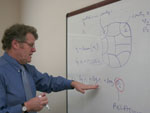|
by Megan Fink
Public Relations
If a picture is worth a thousand words, then disease maps and other
risk assessment visuals speak volumes to public health professionals.
These pictures, developed by an MUSC biostatistics professor, could
help explain why cancers and other deadly diseases turn up in certain
places.
 Dr. Andrew Lawson demonstrates disease mapping as a viable spatial analysis tool for risk assessment. Dr. Andrew Lawson demonstrates disease mapping as a viable spatial analysis tool for risk assessment.
A
critical component of public health resource allocation,
disease-mapping is performed by Andrew Lawson, Ph.D., professor,
Department of Biostatistics, Bioinformatics, and Epidemiology (DBBE).
Lawson’s disease-mapping provides the spatial analysis tools to
identify and justify what resources should go to what areas based on
their estimated risk. The data also are used to detect disease
clusters, which could trigger further research or investigation to
determine the source or path.
Public health officials receive calls and report almost daily from
citizens and organizations about possible disease and other issues
having an adverse health effects for a particular population. Lawson
tracks frequent disease occurrences, and officials assess the risk and
compare it to other areas in the district.
Lawson currently is working on a study that groups similar areas
together in order to discover the map locations where disease outcomes
are the same. Grouping of commonalities also is important for resource
allocation, because public health districts may not show uniform
disease outcomes and, therefore, should not receive uniform health
resources.
“Here’s the infection, now here’s our map of the infection,” said
Lawson. “Where’s it going to go? If you have good tools to predict the
disease path, you can say with more confidence that an area is more
likely going to be infected. So, let’s do something about it.”
Lawson also is embarking on a project analyzing human papillomavirus
(HPV) and cervical cancer in relation to patients with head and neck
cancer. Lawson and his team are looking at the spatial distribution of
cervical cancer and head and neck cancer in South Carolina. He also
just published a paper with Elizabeth Slate, Ph.D., DBBE, and Elizabeth
Hill, Ph.D., DBBE, on the survival rates for prostate cancer in the
state.
Disease surveillance became an interest of Lawson’s after the terrorist
attacks on Sept. 11, 2001, when homeland security and public health
officials grew concerned over potential health-related terrorist
attacks and called for enhanced monitoring of disease outcomes. Lawson
developed methods for surveillance to see where diseases have changed
in particular places.
A
recent recruit from The Arnold School of Public Health at the
University of South Carolina, Lawson also is a World Health
Organization advisor in disease mapping and risk assessment. Working at
MUSC puts Lawson in close proximity to clinical-related topics and
offers a more integrated approach to biostatistics and epidemiology.
“MUSC is the flagship medical university in the state and has a very
dedicated, long-standing presence in terms of biostatistics and
epidemiology,” said Lawson. “The department is stellar, and I work well
with the faculty and staff here.”
Lawson teaches courses worldwide on Bayesian-style disease mapping
methods with the next session being held in December at MUSC. This
course is so popular that it’s already filled to capacity, so the next
open session will be offered in the spring.
Friday, Dec. 12, 2008
|



